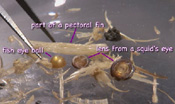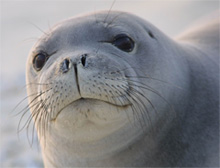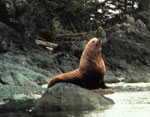Pinnipeds: Seals, Sea Lions, and Walruses
|
Overview
The word pinnipedia translates from Latin as "feather or fin foot," referring to their often large fin-like flippers. All pinnipeds must come ashore to breed, give birth, and nurse their young. Seals, sea lions, and walruses are taxonomically related to other carnivores, including bears, dogs, raccoons, and weasels (including otters).
Three families of living pinnipeds are recognized:
- Phocidae (earless seals or true seals)
- Otaridae (eared or fur seals and sea lions)
- Odobenidae (walrus)
Status of Pinniped Species
All pinnipeds are protected under the Marine Mammal Protection Act (MMPA); some may be designated as "depleted" under the MMPA. Endangered and threatened pinnipeds are further protected under the Endangered Species Act (ESA).
The table below includes pinnipeds found in U.S. waters and endangered/threatened foreign species. Note: Species listed as endangered or threatened under the ESA are, by default, also considered "depleted" under the MMPA.
(E = "endangered"; T = "threatened"; P = "proposed"; D = "depleted"; C = "candidate"; DL = "delisted"; F = "foreign")
| Species | Status |
|---|---|
|
|
|
P-T |
|
P-T (F) |
|
|
|
DL |
|
|
|
T/D (F) |
|
|
|
|
|
E/D |
|
|
|
E/D (F) |
|
|
|
|
|
D |
|
S |
|
|
|
P-T P-T (F) P-T (F) P-T (F) |
|
E/D (F) |
|
|
|
T (F) |
|
|
|
E/D T/D |
|
T/D |
More About Pinnipeds
Phocid seals include elephant seals, several ice seals, monk seals, and harbor seals. All of these seals have rear flippers that point backwards, and they move on land with a vertical undulating motion called "galluphing." They lack external ears and use their hind flippers for propulsion through the water. Typically, phocids have thin fur that does not trap air, therefore, they use blubber for insulation.
Otariids, including fur seals and sea lions, have external ear flaps (hence the name "eared seals"). Sea lions and fur seals can rotate their hind feet forward and move with considerable speed. Otariids are also known for having dense fur that traps air to aid in insulation. They use large, fore flippers for locomotion in the marine environment.
Walruses, the only member of the family Odobenidae, are currently found in both Pacific and Atlantic Arctic ice pack areas, but in colonial times they were found as far south as Sable Island off Nova Scotia. They move in a similar fashion to otariids. One of their most distinctive features is their tusks. They are also known for nearly hairless skin and thin blubber. Similar to phocids, walruses lack external ears. Similar to otariids, walruses can rotate their pelvis so that their hind limbs are under the body. In the water, walruses use either fore flippers (like otariids) or hind flippers (like phocids) for propulsion. The U.S. Fish and Wildlife Service (USFWS) has jurisdiction over walruses.
Main factors for decline
Factors for decline of endangered and threatened pinnipeds include commercial hunting of seals from the 1700s to the early 1900s, coastal development, and competition with humans for prey species.
For More Information
Marine Mammal Stock Assessment Reports
Alaska Seals: NMFS Alaska Region
Seals & Sea Lions: NMFS Northwest Region
California Pinniped Rookeries & Haul-out Sites: NMFS Southwest Regional Office
Environmental Impact Statement (EIS) for Steller Sea Lion and Northern Fur Seal Research
Updated: November 15, 2011






